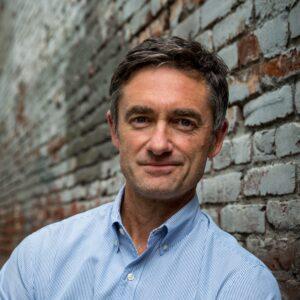
Executive Director
Jesse Jones, Kamari Moeller, and Rich Peterson working to restore a section of the Siuslaw River basin.
As our region turns to wildfire recovery, our Executive Director Jeremy Barnicle looks at how we can build a more equitable, prosperous, and climate-smart future for the long-term.
Earlier this week, I joined a call of Oregon Governor Kate Brown’s new 2020 Wildfire Economic Recovery Council, which is composed of elected officials, state agency heads, and relevant business and community leaders. It seemed like a sensible group with the right charter for its task.
It makes sense for Oregon and the other fire-affected states in the West to have specific efforts at wildfire recovery. Thousands of lives have been upended, and billions of dollars of property have been lost; the recovery effort will be massive. On the wildfire council call this week, an official estimated that the debris clean-up alone would cost $600 million just for his state. Beyond the immediate recovery, we’ve also got to make some changes in the way we manage forests, as outlined here by my colleague Brent Davies, in order to reduce the catastrophic impact of future fires.
So while there is no doubt wildfire recovery is necessary, it doesn’t feel sufficient for the time we are in.
Even before the fires, many rural communities in California, Oregon, and Washington were struggling with the impacts of the COVID crisis and longer term economic decline.
And although our metro areas were spared the worst devastation of the fires, they did experience massive air quality issues, on top of the pandemic, a deep recession, and an intense racial justice reckoning.
This confluence of crises is unprecedented in our region’s modern history, and in Oregon and Washington, the situation demands state-level, multiyear recovery and resilience plans that bring together governments, businesses, and civil society. We’re all better off if we have some shared goals and a framework for how to achieve them. Right now, neither the plans nor the mechanisms to create them seem to exist.
Before it became a slogan for the Biden-Harris campaign, “build back better” was actually a call to action from former Presidents George H.W. Bush and Bill Clinton in the wake of the 2004 Indian Ocean tsunami. That disaster killed more than 200,000 people, devastated coastal communities around Asia, highlighted pre-existing weaknesses in the affected areas, and required a massive, sustained recovery effort.
As we confront the multiple crises here in our home region, we need to think bigger than getting back to “normal.” “Normal” is what has perpetuated systems of racism and economic inequality and caused ecological collapse. Here on the West Coast, we have the opportunity to build back better by working toward a more equitable, prosperous, and climate-smart future.

Waite Ranch
And if I can show some regional pride, the greater Pacific Northwest has a well-deserved reputation for innovation—in good government, land use, health care, technology—and I believe we have an opportunity to model a better form of collective action for other parts of the country at a time when so many of our public institutions are failing us.
There are some key principles to keep in mind as we consider a broader, longer-horizon planning effort:
Putting social inequity—particularly racial inequity—at the center of a recovery effort is the right thing to do and the smart thing to do. It’s the right thing to do because our system is operating outside of commonly held values like fairness and equality: one look at racial disparities in health and economic outcomes will tell you that. It’s the smart thing to do because societies with more racial equity and more shared prosperity are healthier, happier, and more stable. The Reimagine Oregon platform is a good example of a comprehensive, community-led antiracism plan for a state.
Communities have different assets, cultures, and operating environments. Communities have the greatest stake in their own recovery and resilience, so their creativity and sense of ownership are indispensable. Top-down mandates from capital cities will miss the mark, though state governments should help facilitate a planning effort and should play a significant role in implementing a plan. Any state-level plan needs to prioritize investment in local entrepreneurs and in community-driven solutions, something Oregon has done through watershed councils, regional solutions teams, and coordinated care organizations.
The problems we have didn’t develop overnight and neither will the solutions, especially when we are looking at the incredibly destructive and deeply entrenched behaviors that led to racial injustice and global warming. As communities, we need to do some collective priority-setting together. We need to take a deep breath, think beyond biennial budgets and news cycles, and make some long term commitments. If the commitments our states need to make can’t be achieved through the state legislatures, all three West Coast states have a legacy of policymaking through voter-led ballot initiatives. Fraught as the initiative process can be, that could be our best option for voting that longer term vision into reality.
These are unprecedented times, and we need an unprecedented collective response. The tools that got us here are not serving us, and if we are going to give the next generations the equitable, prosperous, and climate-smart future they deserve, we need to try some new damn tools.